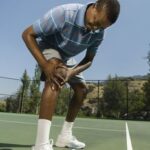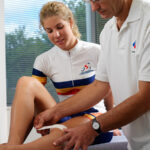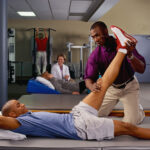Dealing with Sports Injuries: Children & Adults:
Alfred Atanda Jr., MD
Prevention First
 Worried about sports injuries? Don’t sweat it. Think of avoiding injury as just another part of playing by the rules only this rulebook is the one that keeps you from getting hurt. That’s because the best way to deal with sports injuries is to prevent them. Prevention includes knowing the rules of the game you’re playing, using the proper equipment, and playing it safe.
Worried about sports injuries? Don’t sweat it. Think of avoiding injury as just another part of playing by the rules only this rulebook is the one that keeps you from getting hurt. That’s because the best way to deal with sports injuries is to prevent them. Prevention includes knowing the rules of the game you’re playing, using the proper equipment, and playing it safe.
But you’ve practiced with your team, played it safe on the field, and still sustained an injury. Don’t worry, it’s not the end of the world just the beginning of a healing process. Read on to find out what this process is and how you can deal with a sports injury.
What Are Sports Injuries?
Sports injuries are injuries that typically occur while participating in organized sports, competitions, training sessions, or organized fitness activities. These injuries may occur in teens for a variety of reasons, including improper training, lack of appropriate footwear or safety equipment, and rapid growth during puberty.
There are two general types. The first type is an acute traumatic injury. Acute traumatic injuries usually involve a single blow from a single application of force like getting a cross-body block in football.
Acute traumatic injuries include:
a fracture a crack, break, or shattering of a bone
a bruise, known medically as a contusion caused by a direct blow, which may cause swelling and bleeding in muscles and other body tissues
a strain a stretch or tear of a muscle or tendon, the tough and narrow end of a muscle that connects it to a bone
a sprain a stretch or tear of a ligament, the tissue that supports and strengthens joints by connecting bones and cartilage
an abrasion a scrape a laceration a cut in the skin that is usually deep enough to require stitches
The second type of sports injury is an overuse or chronic injury. Chronic injuries are those that happen over a period of time. Chronic injuries are usually the result of repetitive training, such as running, overhand throwing, or serving a ball in tennis.
These include:
stress fractures tiny cracks in the bone’s surface often caused by repetitive overloading (such as in the feet of a basketball player who is continuously jumping on the court)
tendinitis inflammation of the tendon caused by repetitive stretching
epiphysitis or apophysitis growth plate overload injuries such as Osgood-Schlatter disease
Often overuse injuries seem less important than acute injuries. You may be tempted to ignore that aching in your wrist or that soreness in your knees, but always remember that just because an injury isn’t dramatic doesn’t mean it’s unimportant or will go away on its own. If left untreated, a chronic injury will probably get worse over time.
What Can Be Injured?
You may think of your back or your arms and legs as the only places where you could get hurt while playing, but you can get a sports injury anywhere on your body, including your face, neck, head, back, sex organs, hands, and feet.
Head and Neck Injuries
Head injuries include concussions, contusions, fractures, and hematomas. A concussion is a violent jarring or shock to the head that causes a temporary jolt to the brain. If severe enough, or recurrent, concussions can cause brain damage but fortunately this is not common in teens. A hematoma is a bleeding or pooling of blood between the tissue layers covering the brain or inside the brain. All of these injuries can be caused by impact to the head from a fall, forceful shaking of the head, a blow to the head, or whiplash. Whiplash is an injury to the neck caused by an abrupt jerking motion of the head.
Always wear helmets for contact sports and when doing activities like biking and in-line skating to prevent head injuries.
Neck injuries are among the most dangerous. You can hurt your neck through a sudden traumatic injury in sports like mountain climbing, skydiving, horseback riding, gymnastics, diving, rugby, judo, or boxing.
Neck injuries include strains, fractures, contusions, and sprains. Another very common sports-related neck injury is a stinger or burner from stretched nerves in the neck. Most neck injuries are caused by impact to the head or neck sustained during a fall or a blow. Your neck can also be injured a little at a time. Too much strain on your neck can cause increasing pain, sometimes only on one side of your neck. Sometimes you may feel only a slight pain when you move a certain way.
If the injury is severe and there is a chance that the neck might be injured, it’s very important to keep the injured person still with the head held straight while someone calls for emergency medical help. If the person is lying on the ground, do not try to move him or her. Never try to move someone who may have a neck injury a mishandled neck fracture could lead to permanent paralysis or even death.
How do these injuries happen? Serious head and neck injuries occur most often in athletes who participate in contact sports (like football or rugby) or sports with the potential for falling accidents, such as horseback riding.
Back Injuries
Back injuries include sprains, fractures, contusions, stress fractures, and strains and are caused by twists or overexertion of back muscles during bending or lifting movements. These injuries can occur in contact sports like football and ice hockey or in weight lifting, figure skating, gymnastics, dancing, baseball, and basketball.
Sex Organs
When it comes to injuries to the sex organs, guys usually suffer more trauma than girls because the penis and testicles are outside the body and lack natural protection during contact sports. Guys should always wear athletic supporters, or in some sports a cup, to protect the genitals from serious injury.
Injuries to the uterus or ovaries are rare, but breast injuries are common complaints among teen girls. As the breasts develop, they can often be sore, and a blow from a softball or a jab from an elbow, for example, can be painful. Girls should wear supportive sports bras while playing sports or exercising.
Hand and Wrist Injuries
Hand, finger, and wrist injuries include fractures, dislocations, and sprains and often occur in contact sports such as football, lacrosse, and hockey. Hand injuries can result from a fall that forces the hand or fingers backward, a forceful impact to the hands, or a direct blow.
Foot Injuries
Foot injuries can include ligament strains, stress fractures, heel bruises, and swollen growth plates. Because your feet support all of your weight and must absorb a lot of force over and over again, they can be particularly susceptible to injury. Another reason some teens may suffer foot injuries is because of differences in their feet. For example, some people have flat feet or high arches. These differences don’t mean that sports should be avoided, but it does mean that precautions, such as a special shoe insert, may be needed.
Taking Care of Sports Injuries
If your pain progressively increases with activity (what sports medicine doctors call an “upward crescendo”) and causes swelling, limping, or loss of range of motion, you need to see a doctor as soon as possible.
What kinds of pain should you be on the lookout for? Any injury that results in swelling, numbness, intense pain or tenderness, stiffness, or loss of flexibility should be taken seriously.
You should also know the difference between soreness and chronic pain. Soreness is temporary, but chronic pain continues over a greater length of time. For example, it’s not always necessary to see a doctor right away if your shoulder is sore, but you should schedule an appointment if the pain is worsening at any time or if it persists for a week or more. You should also see a doctor if your pain progresses from happening only after playing to happening during sports or if you notice it when you wake up or are doing daily activities.
The most important thing to do when you suspect you are injured is to stop doing whatever sport has caused the injury right away and go see a doctor. For more severe or complicated injuries, it may be best to see a doctor who specializes in sports medicine.
The doctor will examine your injury and use diagnostic tools such as X-rays and magnetic resonance imaging (MRI) to determine the extent of your injury. MRI allows doctors to see soft tissues more clearly than X-rays or CT scans do.
Once the full extent of your injury is known, the doctor usually will start with conservative treatment techniques such as rest and ice to help decrease swelling. Pain relief and anti-inflammatory medicines such as ibuprofen (like Advil or Motrin) may be prescribed. Splints, casts, and surgery also might be needed, depending on the injury.
One of three things will happen next. Your doctor may:
recommend that you not play while you heal
that you play and use a protective device (a knee brace or wrist guard, for example)
that you undergo rehabilitation (physical therapy)
Sports medicine doctors won’t let you play if you are at risk for getting another injury or aggravating an injury you are recovering from.
Getting Back in the Game
If your doctor has asked you to stop playing, your #1 question is probably “When can I play sports again?” This depends on your specific injury, so make sure you discuss this with your doctor. You can do other things while injured to stay fit without making your injury worse but make sure you check with your doctor first. These activities are known as cross training, and they include using stationary cycles, swimming, water therapy, and rowing machines.
Your rehabilitation program will also help you stay fit as you recover. Rehabilitation, or rehab, is the process that gets you back in shape and ready for action again. Rehab may be part of your treatment program and can include exercise, manual therapy from a physical therapist (a specialist who is trained to help you recover from a sports injury), and technology such as ultrasound. Ultrasound equipment is used to heat the injured area. This heat relieves pain, promotes healing, and increases your range of motion.
Playing Safe
What can you do to protect yourself from getting hurt again? Use protective gear such as helmets for contact sports like football that is appropriate to the specific sport.
When you return to play, you might need some new protective gear, including modified shoes (such as those with inserts or arch supports or those designed for use in a particular sport), taping (tape used to wrap a knee, for example, to provide extra support), knee and elbow braces, and mouth guards. These devices help support and protect your body part from strains, direct blows, and possible re injury.
To help prevent re injury, be sure to warm up adequately before practice and games. Remember to take it slow when you first get back into your sport and gradually build back up to your preinjury level.
Also, know your limits. If the previously injured part (or any body part) begins to hurt, stop immediately and rest. Don’t delay in seeking medical attention if the pain persists. It’s your body’s way of telling you something is not right.
So play, but play safe. Try to learn from your experience and do the things that can help you avoid getting hurt again.
What Can Be Injured?
You may think of your back or your arms and legs as the only places where you could get hurt while playing, but you can get a sports injury anywhere on your body, including your face, neck, head, back, sex organs, hands, and feet.
Head and Neck Injuries
Head injuries include concussions, contusions, fractures, and hematomas. A concussion is a violent jarring or shock to the head that causes a temporary jolt to the brain. If severe enough, or recurrent, concussions can cause brain damage but fortunately this is not common in teens. A hematoma is a bleeding or pooling of blood between the tissue layers covering the brain or inside the brain. All of these injuries can be caused by impact to the head from a fall, forceful shaking of the head, a blow to the head, or whiplash. Whiplash is an injury to the neck caused by an abrupt jerking motion of the head.
Always wear helmets for contact sports and when doing activities like biking and in-line skating to prevent head injuries.
Neck injuries are among the most dangerous. You can hurt your neck through a sudden traumatic injury in sports like mountain climbing, skydiving, horseback riding, gymnastics, diving, rugby, judo, or boxing.
Neck injuries include strains, fractures, contusions, and sprains. Another very common sports-related neck injury is a stinger or burner from stretched nerves in the neck. Most neck injuries are caused by impact to the head or neck sustained during a fall or a blow. Your neck can also be injured a little at a time. Too much strain on your neck can cause increasing pain, sometimes only on one side of your neck. Sometimes you may feel only a slight pain when you move a certain way.
If the injury is severe and there is a chance that the neck might be injured, it’s very important to keep the injured person still with the head held straight while someone calls for emergency medical help. If the person is lying on the ground, do not try to move him or her. Never try to move someone who may have a neck injury a mishandled neck fracture could lead to permanent paralysis or even death.
How do these injuries happen? Serious head and neck injuries occur most often in athletes who participate in contact sports (like football or rugby) or sports with the potential for falling accidents, such as horseback riding.
Back Injuries
Back injuries include sprains, fractures, contusions, stress fractures, and strains and are caused by twists or overexertion of back muscles during bending or lifting movements. These injuries can occur in contact sports like football and ice hockey or in weight lifting, figure skating, gymnastics, dancing, baseball, and basketball.
Sex Organs
When it comes to injuries to the sex organs, guys usually suffer more trauma than girls because the penis and testicles are outside the body and lack natural protection during contact sports. Guys should always wear athletic supporters, or in some sports a cup, to protect the genitals from serious injury.
Injuries to the uterus or ovaries are rare, but breast injuries are common complaints among teen girls. As the breasts develop, they can often be sore, and a blow from a softball or a jab from an elbow, for example, can be painful. Girls should wear supportive sports bras while playing sports or exercising.
Hand and Wrist Injuries
Hand, finger, and wrist injuries include fractures, dislocations, and sprains and often occur in contact sports such as football, lacrosse, and hockey. Hand injuries can result from a fall that forces the hand or fingers backward, a forceful impact to the hands, or a direct blow.
 Foot Injuries
Foot Injuries
Foot injuries can include ligament strains, stress fractures, heel bruises, and swollen growth plates. Because your feet support all of your weight and must absorb a lot of force over and over again, they can be particularly susceptible to injury. Another reason some teens may suffer foot injuries is because of differences in their feet. For example, some people have flat feet or high arches. These differences don’t mean that sports should be avoided, but it does mean that precautions, such as a special shoe insert, may be needed.
Taking Care of Sports Injuries
If your pain progressively increases with activity (what sports medicine doctors call an “upward crescendo”) and causes swelling, limping, or loss of range of motion, you need to see a doctor as soon as possible.
What kinds of pain should you be on the lookout for? Any injury that results in swelling, numbness, intense pain or tenderness, stiffness, or loss of flexibility should be taken seriously.
You should also know the difference between soreness and chronic pain. Soreness is temporary, but chronic pain continues over a greater length of time. For example, it’s not always necessary to see a doctor right away if your shoulder is sore, but you should schedule an appointment if the pain is worsening at any time or if it persists for a week or more. You should also see a doctor if your pain progresses from happening only after playing to happening during sports or if you notice it when you wake up or are doing daily activities.
The most important thing to do when you suspect you are injured is to stop doing whatever sport has caused the injury right away and go see a doctor. For more severe or complicated injuries, it may be best to see a doctor who specializes in sports medicine.
The doctor will examine your injury and use diagnostic tools such as X-rays and magnetic resonance imaging (MRI) to determine the extent of your injury. MRI allows doctors to see soft tissues more clearly than X-rays or CT scans do.
Once the full extent of your injury is known, the doctor usually will start with conservative treatment techniques such as rest and ice to help decrease swelling. Pain relief and anti-inflammatory medicines such as ibuprofen (like Advil or Motrin) may be prescribed. Splints, casts, and surgery also might be needed, depending on the injury.
One of three things will happen next. Your doctor may:
recommend that you not play while you heal
that you play and use a protective device (a knee brace or wrist guard, for example)
that you undergo rehabilitation (physical therapy)
Sports medicine doctors won’t let you play if you are at risk for getting another injury or aggravating an injury you are recovering from.
Getting Back in the Game
If your doctor has asked you to stop playing, your #1 question is probably “When can I play sports again?” This depends on your specific injury, so make sure you discuss this with your doctor. You can do other things while injured to stay fit without making your injury worse but make sure you check with your doctor first. These activities are known as cross training, and they include using stationary cycles, swimming, water therapy, and rowing machines.
Your rehabilitation program will also help you stay fit as you recover. Rehabilitation, or rehab, is the process that gets you back in shape and ready for action again. Rehab may be part of your treatment program and can include exercise, manual therapy from a physical therapist (a specialist who is trained to help you recover from a sports injury), and technology such as ultrasound. Ultrasound equipment is used to heat the injured area. This heat relieves pain, promotes healing, and increases your range of motion.
Playing Safe
What can you do to protect yourself from getting hurt again? Use protective gear such as helmets for contact sports like football that is appropriate to the specific sport.
When you return to play, you might need some new protective gear, including modified shoes (such as those with inserts or arch supports or those designed for use in a particular sport), taping (tape used to wrap a knee, for example, to provide extra support), knee and elbow braces, and mouth guards. These devices help support and protect your body part from strains, direct blows, and possible re injury.
 To help prevent re-injury, be sure to warm up adequately before practice and games. Remember to take it slow when you first get back into your sport and gradually build back up to your preinjury level.
To help prevent re-injury, be sure to warm up adequately before practice and games. Remember to take it slow when you first get back into your sport and gradually build back up to your preinjury level.
Also, know your limits. If the previously injured part (or any body part) begins to hurt, stop immediately and rest. Don’t delay in seeking medical attention if the pain persists. It’s your body’s way of telling you something is not right.
So play, but play safe. Try to learn from your experience and do the things that can help you avoid getting hurt again.


